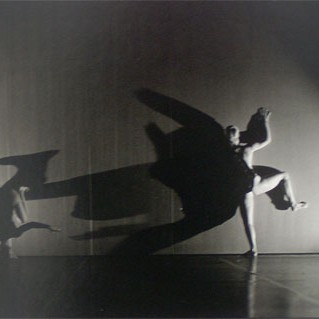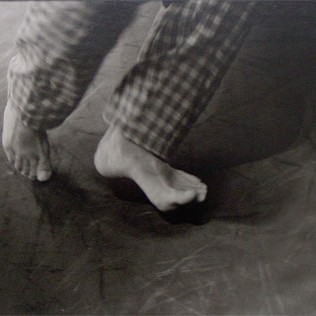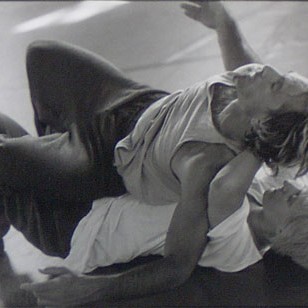Dancing with my eyesIt was during a warm up at the Blackforest Contact Jam in Germany that Thomas Kampe led an exercise in awareness: The game was that you see all the people around you, but you move as though you are invisible. I realized in this moment that this is the feeling I have been moving with over the last four years while taking photos of Contact Improvisation. To reach a state of transparent presence has always been a central aim for me as a photographer. There is of course at first a respect to the atmosphere and situation, where I'm taking pictures. I have often the strange feeling of being a person which is thieving in a way some seconds from other peoples life with each roll of film. While I'm moving among contact dancers I try to follow with my breathing and movement theirs rhythm. Wearing dark unpatterned clothes is also helpful. And with my Leica rangefinder camera I have a quiet and discrete instrument.
To be a photographer is for me not only a profession. It's a way of life, a way of looking at and exploring the world around me. It is the long journey of sensing, of catching and eating information, of feeling more and more familiar with a situation, and then at the end of this process there is only a single moment, this part of second, when I'm pushing my finger on the shutter release of the camera. This is the moment of decision. (I don't manipulate my photos afterwards, there is no cropping, only may be some changing of grayscale or gradation.)
There has to be a direct flow from my eyes to the index finger of my right hand … To make really good pictures I have to switch off all my thinking about compositions, “right” moments or about what could happen in the next second. I have to f e e l composition and right moment. The instruction comes from outside, from the dance! This is a difference to my work as a press photographer. There I regularly find myself in situations where I already know, which pictures the client or the editorial office expect from a specific situation. Often I know or can guess what will happen in the next moment. There is much more control inside me.
In following Contact Improvisation, I found a great subject to fulfill my personal idea of photography. I feel now, that there is a big similarity between the process of improvising dance and taking photographs. It is about the importance of what leads up to the decision to act, about the way “before”. Both look at first simplier than they are. There is a similar extended period of exploring with all senses of the human body before a performer comes to the “right moment” (from where there is also no way back). It's indispensable to understand the importance of this process to understand our professions as art.
I had an ongoing interest in theatre- and dance-photography over some years before my first meetings with CI around 1995. It was always the interaction of space, light and movement,
which fascinated me. But in Contact, I felt a new mysterious and sensual dimension. I discovered, that there is a “fourth” dimension of space, which is changed by the movement of the performer. To fix this mystery on some square centimeters of film is a real challenge. This discovery influences also my seeing in everyday live. With the knowledge about this “higher dimensional” space I sometimes feel like I'm x-raying things that I'm looking into.
Photographing Contact is a gift for me because it keeps my eyes open and sensitive and it is far away from my everyday work as press photographer. Also, I get a lot of feedback from dancers who look at my pictures. This is a big difference from the "normal" photographic work where people are used to looking at hundreds of photos each day and forget them in the next moment...
In my many travels to conferences, jams and festivals, I introduce myself as "strictly non-dancer." It's true: I never danced contact. I never felt the sensation of touching in a dance or rolling points of contact around my body. Why don't I dance? It is the most usual question when I talk with somebody about my work. Maybe I want to preserve inside of myself a kind of. Often I've noted that people who are also not involved in dancing CI enjoy my pictures and spot a lot of stories in them. But of course, we have the same "untouched" way of looking.
But also, as a non-dancer, I know that the "defining" of CI is a never-ending story. And the longer I work on my invisibility, the less I feel myself successful in that. More and more I realize that there are a lot of mysterious connections between photographer and dancers. How do dancers react or change their dance when they feel the camera is there? Could it be that two dancers and a photographer find themselves accidentally in a trio situation? How do I change my way of moving when I'm among the contacters? It was a very special situation, when I “watched” Material for the Spine classes by Steve Paxton in Bratislava, autumn 2002. Every day I had the feeling that there are some more bones in my body. One moment I realized that I start to move from my center …
Could it be that I'm already dancing?
Thomas Häntzschel
(
published in “Contact Quarterly” winter/spring 2004)
.png)


